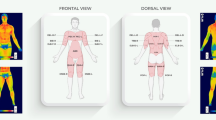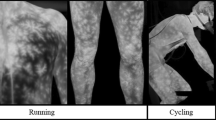Abstract
In this paper we used high-resolution thermal imaging to visualize the human whole body anterior cutaneous temperature (T c) variations in well-trained runners during graded exercise. Fifteen male volunteers underwent a graded treadmill test until reaching their individual maximal heart rate. Total body T c decreased as the subjects started the exercise. Thighs and forearms exhibited the earliest response. A further T c diminution occurred with the progress of the exercise. At the exercise interruption, T c values were in average 3–5 °C lower than at baseline. T c increased during recovery from exercise. Forearms and thighs exhibited the earliest increase, followed by total body T c increase. Thermal imaging documented the presence of hyperthermal spots (occasionally tree-shaped) due to the presence of muscle perforator vessels during baseline and recovery, but not during exercise. The results we report indicate that thermal infrared imaging permits the quantitative evaluation of specific cutaneous whole body thermal adaptations which occur during and after graded physical activity. Thus providing the basis for evaluating local and systemic cutaneous blood flow adaptation as a function of specific type, intensity and duration of exercise, and helping to determine the ideal conditions (in terms of environment and apparel) in which physical activities should be conducted in order to favor thermal regulatory processes.



Similar content being viewed by others
References
Aldemir, H., G. Atkinson, T. Cable, B. Edwards, J. Waterhouse, and T. Reilly. A comparison of the immediate effects of moderate exercise in the late morning and late afternoon on core temperature and cutaneous thermo-regulatory mechanisms. Chronobiol. Int. 17:197–207, 2000.
American Society of Heating, Refrigerating and Air-Conditioning Engineers (ASHRAE). Handbook Fundamentals. Atlanta, GA: ASHRAE, 1985, pp. 1–24.
Binzoni, T., T. Leung, D. T. Delpy, M. A. Fauci, and D. Rufenacht. Mapping human skeletal muscle perforator vessels using a quantum well infrared photodetector (QWIP) might explain the variability of NIRS and LDF measurements. Phys. Med. Biol. 49(12):165–173, 2004.
Brengelmann, G. L., J. M. Johnson, L. Hermansen, and L. B. Rowell. Altered control of skin blood flow during exercise at high internal temperatures. J. Appl. Physiol. 43:790–794, 1977.
Chijiwa, T., K. Arai, N. Miyazaki, S. Igota, and N. Yamamoto. Making of a facial perforator map by thermography. Ann. Plast. Surg. 44(6):596–600, 2000.
Fauci, M. A., R. Breiter, W. Cski, W. Fick, R. Koch, J. Ziegler, and S. D. Gunapala. Medical Infrared Imaging—differentiating facts from fiction, and the impact of high precision quantum well infrared photodetectors camera systems, and other factors, in its reemergence. Infrared Phys. Technol. 42:337–344, 2001.
Ferreira, J. J. A., L. C. S. Mendonc, A. L. A. O. Nunes, A. C. C. Andrade Filho, J. R. Rebelatto, and T. F. Salvini. Exercise-associated thermographic changes in young and elderly subjects. Ann. Biomed. Eng. 36:1420–1427, 2008.
Itoh, Y., and K. Arai. Use of recovery-enhanced thermography to localize cutaneous perforators. Ann. Plast. Surg. 34(5):507–511, 1995.
Johnson, J. M. Exercise and the cutaneous circulation. Exercise Sport Sci. Rev. 20:59–97, 1992.
Kenney, W. L., and J. M. Johnson. Control of skin blood flow during exercise. Med. Sci. Sports Exerc. 24(3):303–312, 1992.
Merla, A., L. Di Donato, and G. L. Romani. Quantifying the relevance and stage of disease with the tau image technique. IEEE Eng. Med. Biol. 21:86–91, 2002.
Merla, A., and G. L. Romani. Functional infrared imaging in clinical applications. In: The Biomedical Engineering Handbook, edited by J. D. Bronzino. New York, NY: CRC Press, 2005, pp. 32.1–32.13.
Roganski, A. Infrared detectors: an overview. Infrared Phys. Technol. 43:187–210, 2002.
Rowell, L. B. Human cardiovascular adjustments to exercise and thermal stress. Physiol. Rev. 54:75–179, 1974.
Tangherlini, A., A. Merla, and G. L. Romani. Field-warp registration for biomedical high-resolution thermal infrared images. Conf. Proc. IEEE Eng. Med. Biol. Soc. 1:961–964, 2006.
Taylor, G. I., M. P. Gianoutsos, and S. F. Morris. The neurovascular territories of the skin and muscles: anatomic study and clinical implications. Plast. Reconstr. 94:1–36, 1994.
Vainer, B. G. FPA-based infrared thermography as applied to the study of cutaneous and stimulated vascular response in humans. Phys. Med. Biol. 50:R63–R94, 2005.
Zontak, A., S. Sideman, O. Verbitsky, and R. Beyar. Dynamic thermography: analysis of hand temperature during exercise. Ann. Biomed. Eng. 26:988–993, 1998.
Author information
Authors and Affiliations
Corresponding author
Rights and permissions
About this article
Cite this article
Merla, A., Mattei, P.A., Di Donato, L. et al. Thermal Imaging of Cutaneous Temperature Modifications in Runners During Graded Exercise. Ann Biomed Eng 38, 158–163 (2010). https://doi.org/10.1007/s10439-009-9809-8
Received:
Accepted:
Published:
Issue Date:
DOI: https://doi.org/10.1007/s10439-009-9809-8




